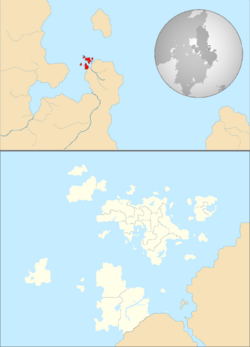Kyuko
Kyuko 九港 | |
|---|---|
 Location of Kyuko | |
| Official languages | Tuskish Ashiharan |
| Demonym(s) | Kyukoan |
| Sovereign state | Tuskval |
| Government | Devolved government within Federal presidential republic |
| Vidar Bruun | |
• Governor | Riku Takahama |
| Tomio Okamura | |
| Legislature | General Court |
| Autonomy within the Republic of Tuskval | |
| 3 June 1661 | |
| 14 May 1825 | |
| 28 September 1842 | |
| 3 June 1889 | |
| 19 October 1931 | |
| 11 March 1995 | |
| Population | |
• 2016 census | 2,445,689 |
| GDP (PPP) | $142 billion estimate |
• Per capita | $58,221 |
| GDP (nominal) | $111 billion estimate |
• Per capita | $45,542 |
| Gini (2018) | 55.6 high |
| HDI (2016) | 0.928 very high |
| Currency | Mark (Պ) (KVM) |
| Driving side | left |
| Calling code | +39 |
Kyuko (Ashiharan: 九港), officially the Free and Sovereign State of Kyuko (Tuskish: Frie og Suveræne Staten Kyuko) is a Free State of Tuskval on the eastern side Ashihara in Kokai Bay. It has a population of 2,445,689, of various nationalities, in a 277-square-kilometre area, making it one of the most densely populated areas in the world. There are two official languages of Kyuko: Tuskish, and Ashiharan; most Kyukoans are bilingual, with Ashiharan serving as the states' lingua franca, while Tuskish is the national language
Once a sparsely populated area of fishing villages, the state has become one of the world's most significant centres of finance, and commercial ports. Since the easing of Tusco-Ashiharan relations in 1995 it has also become a cultural and economic centre for Ashihara. Tuskval acquired Kyuko in 1661 by purchasing it from the local daimyo, and extended its territory in the Orange Wars. Tuskval's permanent sovereignty over Kyuko was affirmed by the 1889 Convention of Naniwa, and again by the Tusco-Ashiharan Joint Declaration in 1995.
Kyuko is classified as an alpha+ world city, with one of the largest concentrations of high-net-worth individuals in the world, though despite this and a high income per capita there is remains serious income inequality. Despite this Kyuko places highly in key social indicators: education, healthcare, quality of life, personal safety and housing, with a home-ownership rate of 85%.

